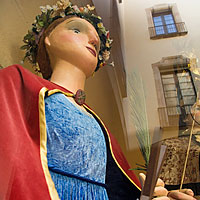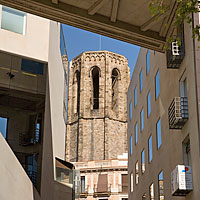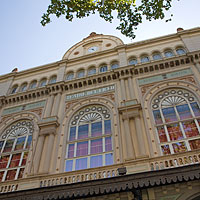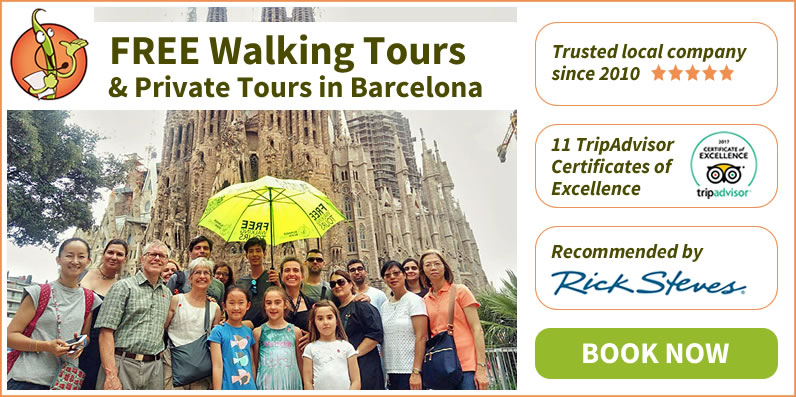We left the bustling Rambla in the first part of this article on the corner of Portaferrisa Street. It is now time to continue on and find out what is waiting for us on the most famous street in Barcelona.
The first building we see on our right, in front of the flower stands, is “Palau de la Virreina“. This was the residence of the Viceroy of Peru and nowadays, a cultural centre for art and photography shows. After you enter, the exhibition space is at the back on your left but just in front of it, behind a glass case, you can see some of the city’s giants. Try to find King Jaume I and his wife, the eagle of Barcelona and our patron saint: Saint Eulalia. She is the little girl holding the x-shaped cross. Her festival is held every February and it is a great opportunity to enjoy Catalan traditions even in the winter months.

A few metres ahead you will find the entrance to one of the most popular food markets in the world: La Boqueria. The Catalan Art Noveau entrance displays the city’s coat of arms and the market’s official name: Mercat de Sant Josep, reminding us that this was the site of another monastery (Saint Joseph’s). Our office is very close by so buying some fresh delicacies at the fish stands has become quite a tradition in my house. Although this indoor market dates from 1840, there has always been some kind of food trade in this part of La Rambla. The arches surrounding the market are a reminder of the original plan for this site: a Neoclassical square in the style of Plaça Reial (down the street) that was left unfinished. The food stands outside were eventually welcomed to the inside of the square creating the new market. Look around to see the porticoes that remind us of the failed project square.
There are many versions of where the strange name Boqueria could come from. One legend tells of a king who brought back an extremely ornate Moorish door from one of his campaigns. He decided to place it just here, as one of the main entrances to the city. It was so beautiful that when people saw it they were left open-mouthed, an adjective that in Catalan is called Badoqueria. Another theory comes from the time when goat’s meat was sold in this area. If we consider that boc is a goat in Catalan, a Boqueria would be a place where this type of meat is sold. The last version is also related to goats and talks of the Jews who sold their meat on the stands just here. To the Christians, Jewish men looked like goats with their long pointy beards. Some of these theories don’t make much historical sense but they are now part of the city’s folklore. Pick the one you prefer and don’t forget to try some tapas at one of the traditional indoor stands.

All the buildings of the Gothic Quarter are hidden by the tall houses facing La Rambla. There is only one exception: the Basilica of Santa María del Pi. Funds ran out while this Gothic temple was being built. Only the bell tower was missing so the people in the neighbourhood asked a wealthy gipsy for money to complete it. He agreed but with two conditions attached. Firstly, that the bell tower should be a lot taller than what was originally planned. Secondly, the buildings facing this part of La Rambla couldn’t raise a certain height so the church tower would always be visible. It is a lovely city legend that modern architects have respected in a way. Through a clever design of the white modern building on your left catch a glimpse of the bell tower of Santa María del Pi. Coincidence? We prefer to think not.
Continue down the so-called Rambla dels ocells or Birds Rambla, named after the multiple stands that used to sell birds and other caged household pets. Most of these stands were closed down by the city council a couple of years ago. This could open a long discussion on the whole issue of animal rights. However, the new souvenir shops that replaced them sure don’t add anything interesting to this part of the boulevard.
Pass the stands and congratulate yourself for arriving to the Centre of Barcelona! The big Joan Miró mural on the floor marks Pla de La Boqueria, the old traditional centre of the city. Here is where the main gates of the medieval town stood. Here is where all door numbers start from. And here is also where some of the gallows of the city used to be. The Catalan artist Joan Miró was born not far from this spot and in 1976 donated to the city of Barcelona 3 of his works. One is at the airport to welcome the visitors from the air. The second one, in Sants, is for those that come by land. If you have arrived by sea on a cruise, this ground mosaic is the one for you.
Search for the Chinese dragon that seems to be coming out of the corner of the house on the left. This is the Casa Bruno Cuadros, a wonderful example of the fascination for oriental and Egyptian cultures in the late 1800s. The ground floor is now a bank but under the dragon, you have the answer to the original use of the building: an umbrella shop!

The main Opera House is just on your right a few metres down. The Liceu Theatre might not be the oldest in the city (we will see that one on the next post) but it is certainly the one that has more stories to tell. Although the main façade dates from the original building in 1847, the Liceu was burned down twice during its history: first in 1861 and more recently in 1994. To contribute a bit more to its black legend, at the end of the XIX century, a young anarchist called Santiago Salvador threw two bombs on the main floor killing 20 people. Not a bad place for a performance of The Phantom of the Opera, don’t you think?
It is time to finish this part of the walk. What better way than having a coffee at the beautiful Café de la Opera, just across the street. Get a feel for the Modernista and Neoclassical cafe of the 1920s and wait for the last part of this series on La Rambla. Coming soon, I promise 🙂
Photographs by Gorka Regidor











Such interesting commentaries. I’d love to read more.
Hi Sonya,
The 3rd and final part will be coming soon. I am glad you enjoyed reading it.
Gorka